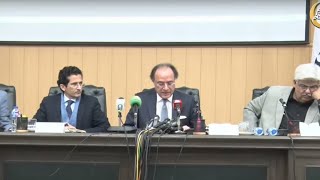The sustainable growth rate of Pakistan's economy is on an upward trajectory but has not yet reached the point where 7-8 percent growth can be sustained.
These views were expressed by Dr Shaghil Ahmed, Acting Managing Director, Social Policy and Development Centre (SPDC) in his presentation while releasing the SPDC Annual Review of the State of the Economy in the light of the Pakistan Economic Survey 2005-06 and the Federal Budget 2006-07 here on Tuesday.
The Review presents an in-depth analysis of the economic situation and policies.
Dr Shaghil Ahmed acknowledged the improvements in economic performance and an increase in the economy's sustainable rate of growth over the past few years, which are in part a result of the improved macroeconomic policy environment.
Although economic activity has decelerated, growth is still occurring at a robust pace despite last October's devastating earthquake.
However, Dr Ahmed also pointed towards some worrisome factors present in the economic situation that result from the growing macroeconomic imbalances. These imbalances manifest themselves in the form of a level of domestic demand that is much higher than domestic production, a huge trade deficit, an increase in the fiscal deficit and a failure of inflation to recede to an acceptable level.
The imbalances pose serious downside risks to the economy and threaten the hard-earned macroeconomic stability and policy credibility. If not controlled, they could jeopardise the very objective of high long-term sustainable growth with price stability.
The SPDC Review also highlights both positive and negative aspects of the Federal Budget 2006-07. It accepts that the post-earthquake reconstruction expenditures and a large increase in the allocations for public sector development programmes largely drive the rise in the fiscal deficit.
The earthquake-related spending is essential and the development programmes are potentially a very pro-poor aspect of the budget and are to be lauded.
However, not enough has been done by way of expenditure switching and raising of tax revenues to finance these larger expenditures in a more sustainable way. As a result, the expansionary stance of fiscal policy has continued, which will make it much more difficult to control inflation.
The official figures released by the GoP recently imply a phenomenal decrease in poverty in just four years from 2001 to 2005. The stance of the SPDC Review on this issue is that non-availability to the public of the full Pakistan Social Living-Standards Measurement (PSLM) Survey data set on which the official figures are based makes an objective analysis of the situation difficult.
A significant reduction in poverty seems plausible given the strong growth and the increases in public development expenditures in recent years.
At the same time, the official figures are likely to represent a substantial overestimate of the extent of the poverty reduction in the presence of some clear offsetting factors. These include high inflation and growing income disparities and other inequalities, which is poverty increasing.
According to SPDC's analysis, there is a need to let domestic demand growth slow further, given that we are not quite yet at the point where 7-8 percent growth is sustainable, that capacity constraints have been reached and that inflation remains high. In his concluding remarks, Dr Shaghil Ahmed said that at the moment there is no trade-off between growth and inflation.
The choices are to let growth slow somewhat with less price pressures and smaller macroeconomic imbalances, or to try to grow faster than is possible with the result that growth will fall more abruptly and with more disruptive consequences. Some more details of SPDC's Annual Review of the State of the Economy are provided below:
MACROECONOMIC ANALYSIS: Economic growth slowed from 8.6 percent in FY05 to 6.6 percent in FY06. The performance across sectors has become much more uneven. In particular, agricultural growth has decreased from 6.7 percent to just 2.5 percent, while manufacturing growth has also slowed from 12.6 percent to 8.6 percent.
Services growth continued at a high pace of 8.5 percent, with the finance and insurance sub-sector should grow by 23 percent in FY07. SPDC's analysis suggests that the bumper cotton crop contributed significantly to the high overall as well as high agricultural growth in FY05 and the fall in cotton production took away from growth in FY06, partly explaining the deceleration.
On the expenditure side, growth in consumption and imports has slowed but remains high at nearly eight percent and 24 percent, respectively, in FY06. The investment picture appears to have improved, but there have been substantial data revisions for FY04 and FY05, which have not been well explained by the government. As such, the true investment picture remains unclear.
Growth of domestic demand at 8.1 percent continued to outpace the growth of domestic output at 6.2 percent (as measured by real GDP at market prices) in FY06. On the expenditure side, consumption remained the main driver of growth, while net exports shaved off nearly two percentage points of growth in FY06.
The relative price of investment has risen by about 30 percent since FY03, with the result that the fixed investment-to-GDP ratio was 18.4 percent in FY06 if measured by nominal values but only 14.3 percent if measured by real values.
Inflation, which had picked up sharply after FY04, receded somewhat in FY06 dropping to eight percent, based on data through May. However, core inflation - which excludes the food and energy components -rose slightly to 7.2 percent. By one statistical measure, the potential output growth of Pakistan's economy has increased from four percent in FY00 to about six percent in FY06, a creditable achievement.
However, with actual output growth being above potential output growth for the past few years, the output gap - the deviation of the level of actual output from the level of potential output - has become positive. This is a source of continued inflationary pressures and if growth of seven percent is targeted, the output gap will continue to grow and these pressures will not abate.
In the first nine months of FY06, imports surged 30 percent over the corresponding period of the previous year while exports rose 11 percent. This put the merchandise trade balance, measured at an annual rate, in the first nine months of FY06 at more than 6.5 times its value in FY04.
Moreover, the external deficit on services has now become 88 percent of the merchandise deficit. Thus, although net transfer payments (including remittances) have increased somewhat, they are now financing about 60 percent of the trade deficit on goods and services relative to nearly 85 percent before.
A disruptive correction of the trade deficit through sudden import compression caused either by a sharp slowdown in economic activity or a sharp depreciation of the currency is a significant downside risk, according to the SPDC report.
FISCAL ANALYSIS: The fiscal deficit is projected to increase to 4.5 percent of GDP in FY07, largely as a result of the increased allocation to the Public Sector Development Programme (PSDP), including allocations for the Earthquake Relief and Reconstruction Authority (ERRA).
External resources (including external borrowing) and privatisation receipts ended up financing a greater share of the deficit in FY06 than was anticipated. The share of bank borrowings was less than anticipated but still amounted to about 1/5th.
In FY07, bank borrowings are expected to increase 110 percent, which is not a good sign in the current environment of high inflation. Non-bank borrowings on the other hand are expected to decline 70 percent.
In addition to the pro-poor development expenditures, there are some other relief measures in the budget for FY07 as well, including a 25 percent increase in the minimum wage, an increase in the tax exempt level of income and a decrease in the effective tax rates of low-salaried workers.
There is also a substantial increase in food and other subsidies. However, the SPDC report cautions against overestimating the importance of the subsidy and relief measures in the budget.
Not counting the tax relief, the subsidies and relief amount to Rs 109 billion slated for FY07; as a share of projected GDP this amounts to 1.25 percent, which is only slightly higher than the 1.1 percent of GDP value for FY06.
The federal government's current expenditures are expected to fall about four percent in FY07 relative to the revised estimates of FY06. It is important to note, however, that the revised estimates represented a 12 percent overshooting of the original target, which continues the tendency year after year for current expenditures to substantially exceed their target.
The CBR tax receipts in FY06 were two percent above target, with indirect taxes being about on track and direct taxes exceeding the target by about five percent. However, this was partly due to inflation and, therefore, nominal income being higher than originally envisaged.
The SPDC Review points out the tax-to-GDP ratio hardly increased at all, from 9.0 percent in FY05 to 9.1 percent in FY06. Moreover, although tax revenue is projected to increase 18 percent in FY07 if we factor in the increase in nominal income from the government's growth and inflation targets, the tax-to-GDP ratio would increase only modestly to 9.6 percent in FY07 from 9.1 percent in FY06.
The initiatives for new taxes in FY07 fall well below expectations - all of the new taxes together will raise Rs25 billion, or only 0.3 percent of projected GDP. The changes in the existing income tax structure arc also inadequate as they will, on the whole, make the tax system less progressive.
The changes result in a substantial reduction in the effective tax rates of the high-salaried class, which will increase income inequality.
POVERTY AND UNEMPLOYMENT: According to the GoP, poverty declined from 34.5 percent in 2001 to 24 percent in 2005, which is a huge reduction of 10 percentage points or 31 percent in just four years. The government should release the PSLM Survey data, on which these figures are based, to the public immediately so that more informed debate on these figures can occur.
Empirically, there is an inverse relationship in Pakistan (as is true elsewhere as well) between changes in poverty and changes in economic growth.
Thus, some reduction in poverty is to be expected given the strong growth. But inflation is high and income inequality is also growing. During the period FYO2-FYO5, monthly real consumption of the richest 20 percent of the population grew almost four times more than the consumption of the poorest 20 percent.
Given these partially offsetting factors, the extent of the poverty reduction seems to be overestimated by the PSLM data.
Given that the Labour Force Survey (LFS) is being conducted for the first time on a quarterly basis, it is difficult to analyse the true employment picture.
The government claims a creation of 5.82 million new jobs from FY04 to December 2005, but this is based on a comparison of the new quarterly LFS with the older ones based on annual data. Such a comparison is not valid because of changes in the sampling framework and the presence of possible seasonal factors.
This is confirmed by some implausible results that emerge when we do compare the new quarterly LFS with the previous annual one using somewhat desegregated data as well.
These implausible results include that nearly 80 percent of the new jobs created were in rural areas, that the labour force in agriculture has increased while that in trade and services has declined and that female literacy rates have risen in rural areas but declined in urban areas.
Thus, SPDC cautions against any inferences being drawn about employment and other trends from a comparison of the new quarterly LFS with the previous annual ones.
BR100
11,987
Increased By
93.1 (0.78%)
BR30
37,178
Increased By
323.2 (0.88%)
KSE100
111,351
Increased By
927.9 (0.84%)
KSE30
35,039
Increased By
261 (0.75%)





















Comments
Comments are closed.